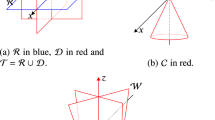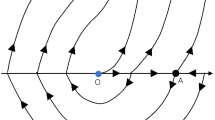Abstract
The planar visible fold is a simple singularity in piecewise smooth systems. In this paper, we consider singularly perturbed systems that limit to this piecewise smooth bifurcation as the singular perturbation parameter \(\epsilon \rightarrow 0\). Alternatively, these singularly perturbed systems can be thought of as regularizations of their piecewise counterparts. The main contribution of the paper is to demonstrate the use of consecutive blowup transformations in this setting, allowing us to obtain detailed information about a transition map near the fold under very general assumptions. We apply this information to prove, for the first time, the existence of a locally unique saddle-node bifurcation in the case where a limit cycle, in the singular limit \(\epsilon \rightarrow 0\), grazes the discontinuity set. We apply this result to a mass-spring system on a moving belt described by a Stribeck-type friction law.










Similar content being viewed by others
Change history
13 October 2023
A Correction to this paper has been published: https://doi.org/10.1007/s00332-023-09980-4
16 May 2023
A Correction to this paper has been published: https://doi.org/10.1007/s00332-023-09908-y
References
Berger, E.J.: Friction modeling for dynamic system simulation. Appl. Mech. Rev. 55(6), 535–577 (2002)
Bonet, C., M-Seara, T.: Chaos in the hysteretic grazing-sliding codimension-one saddle-node bifurcation of piecewise dynamical systems. In: A: Congreso de Ecuaciones Diferenciales y Aplicaciones y Congreso de Matematica Aplicada. “CEDYA 2017, pp. 73–77 (2017)
Bonet-Revés, C., M-Seara, T.: Regularization of sliding global bifurcations derived from the local fold singularity of Filippov systems. Discrete Contin. Dyn. Syst. Ser. A 36(7), 3545–3601 (2016)
Bossolini, E., Brøns, M., Kristiansen, K.U.: Canards in stiction: on solutions of a friction oscillator by regularization. SIAM J. Appl. Dyn. Syst. 16(4), 2233–2258 (2017)
Bossolini, E., Brøns, M., Kristiansen, K.U.: Singular limit analysis of a model for earthquake faulting. Nonlinearity 30(7), 2805–2834 (2017)
Buzzi, C.A., da Silva, P.R., Teixeira, M.A.: A singular approach to discontinuous vector fields on the plane. J. Differ. Equ. 231, 633–655 (2006)
Desroches, M., Jeffrey, M.R.: Canards and curvature: nonsmooth approximation by pinching. Nonlinearity 24(5), 1655–1682 (2011)
di Bernardo, M., Budd, C.J., Champneys, A.R., Kowalczyk, P.: Piecewise-Smooth Dynamical Systems: Theory and Applications. Springer, Berlin (2008)
Dumortier, F., Roussarie, R.: Canard cycles and center manifolds. Mem. Am. Math. Soc. 121, 1–96 (1996)
Ebers, J.J., Moll, J.L.: Large-signal behavior of junction transistors. Inst. Radio Eng. Conv. Rec. 42(12), 1761–1772 (1954)
Fenichel, N.: Persistence and smoothness of invariant manifolds for flows. Indiana Univ. Math. J. 21, 193–226 (1971)
Fenichel, N.: Asymptotic stability with rate conditions. Indiana Univ. Math. J. 23, 1109–1137 (1974)
Fenichel, N.: Geometric singular perturbation theory for ordinary differential equations. J. Differ. Equ. 31, 53–98 (1979)
Filippov, A.F.: Differential Equations with Discontinuous Righthand Sides. Mathematics and its Applications. Kluwer Academic Publishers, Cambridge (1988)
Goldbeter, A., Koshland, D.E.: An amplified sensitivity arising from covalent modification in biological systems. Proc. Natl. Acad. Sci. 78(11), 6840–6844 (1981)
Guglielmi, N., Hairer, E.: Classification of hidden dynamics in discontinuous dynamical systems. SIAM J. Appl. Dyn. Syst. 14(3), 1454–1477 (2015)
Heslot, F., Baumberger, T., Perrin, B., Caroli, B., Caroli, C.: Creep, stick-slip, and dry-friction dynamics—experiments and a heuristic model. Phys. Rev. E 49(6), 4973–4988 (1994)
Hogan, S.J., Homer, M.E., Jeffrey, M.R., Szalai, R.: Piecewise smooth dynamical systems theory: the case of the missing boundary equilibrium bifurcations. J. Nonlinear Sci. 26(5), 1161–1173 (2016)
Jelbart, S., Kristiansen, K.U., Szmolyan, P., Wechselberger, M.: Singularly perturbed oscillators with exponential nonlinearities (2019). arXiv:1912.11769
Jelbart, S., Kristiansen, K.U., Wechselberger, M.: Singularly perturbed boundary focus bifurcations (2020)
Jones, C.K.R.T.: Geometric Singular Perturbation Theory. Lecture Notes in Mathematics, Dynamical Systems (Montecatini Terme). Springer, Berlin (1995)
Kaklamanos, P., Kristiansen, K.U.: Regularization and geometry of piecewise smooth systems with intersecting discontinuity sets. SIAM J. Appl. Dyn. Syst. 18(3), 1225–1264 (2019)
Kosiuk, I., Szmolyan, P.: Geometric singular perturbation analysis of an autocatalator model. Discrete Cont. Dyn. Syst. Ser. S 2(4), 783–806 (2009)
Kosiuk, I., Szmolyan, P.: Scaling in singular perturbation problems: blowing up a relaxation oscillator. SIAM J. Appl. Dyn. Syst. 10(4), 1307–1343 (2011)
Kosiuk, I., Szmolyan, P.: Geometric analysis of the Goldbeter minimal model for the embryonic cell cycle. J. Math. Biol. 72(5), 1337–1368 (2016). https://doi.org/10.1007/s00285-015-0905-0
Kristiansen, K.U., Szmolyan, P.: Relaxation oscillations in substrate-depletion oscillators close to the nonsmooth limit. arXiv:1909.11746 e-prints (2019). https://arxiv.org/pdf/1909.11746.pdf
Kristiansen, K.U.: A new type of relaxation oscillation in a model with rate-and-state friction: paper. Nonlinearity 33(6), 2960–3037 (2020). https://doi.org/10.1088/1361-6544/ab73cf
Kristiansen, K.U.: Blowup for flat slow manifolds. Nonlinearity 30(5), 2138–2184 (2017)
Kristiansen, K.U.: Geometric singular perturbation analysis of a dynamical target mediated drug disposition model. J. Math. Biol. 79(1), 187–222 (2019)
Krupa, M., Szmolyan, P.: Extending geometric singular perturbation theory to nonhyperbolic points—fold and canard points in two dimensions. SIAM J. Math. Anal. 33(2), 286–314 (2001)
Krupa, M., Szmolyan, P.: Relaxation oscillation and canard explosion. J. Differ. Equ. 174(2), 312–368 (2001)
Kuehn, C.: Multiple Time Scale Dynamics. Springer, Berlin (2015)
Kuznetsov, YuA, Rinaldi, S., Gragnani, A.: One parameter bifurcations in planar Filippov systems. Int. J. Bif. Chaos 13, 2157–2188 (2003)
Laidler, K.J.: Chemical Kinetics. Harper and Row, New York (1987)
Llibre, J., da Silva, P.R., Teixeira, M.A.: Regularization of discontinuous vector fields on \({\mathbb{R}}^3\) via singular perturbation. J. Dyn. Differ. Equ. 19, 309–331 (2007)
Llibre, J., Da Silva, P.R., Teixeira, M.A.: Study of singularities in nonsmooth dynamical systems via singular perturbation. SIAM J. Appl. Dyn. Syst. 8(1), 508–526 (2009)
Makarenkov, O., Lamb, J.S.W.: Dynamics and bifurcation of nonsmooth systems: a survey. Physica D 241, 1826–1844 (2012)
Munkres, J.R.: Topology. Pearson, London (2000)
Olver, F.W.J., Lozier, D.W., Boisvert, R.F., Clark, C.W.: NIST handbook of mathematical functions. J. Geom. Sym. Phys. 22, 99–104 (2011)
Panazzolo, D., da Silva, P.R.: Regularization of discontinuous foliations: blowing up and sliding conditions via fenichel theory. J. Differ. Equ. 263(12), 8362–8390 (2017)
Papangelo, A., Ciavarella, M., Hoffmann, N.: Subcritical bifurcation in a self-excited single-degree-of-freedom system with velocity weakeningstrengthening friction law: analytical results and comparison with experiments. Nonlinear Dyn. 90(3), 2037–2046 (2017)
Perko, L.: Differential Equations and Dynamical Systems. Springer, Berlin (2001)
Schecter, S.: Exchange lemmas 2: general exchange lemma. J. Differ. Equ. 245(2), 411–441 (2008)
Sotomayor, J., Teixeira, M.A.: Regularization of discontinuous vector fields. In: Proceedings of the International Conference on Differential Equations, Lisboa, pp. 207–223 (1996)
Szmolyan, P.: Progress and challenges in singular perturbations. In: Talk at EquaDiff Conference in Bratislava, Slovakia (2017)
Tyson, J.J., Chen, K.C., Novak, B.: Sniffers, buzzers, toggles and blinkers: dynamics of regulatory and signaling pathways in the cell. Curr. Opin. Cell Biol. 15(2), 221–231 (2003)
Uldall Kristiansen, K., Hogan, S.J.: On the use of blowup to study regularizations of singularities of piecewise smooth dynamical systems in R3. SIAM J. Appl. Dyn. Syst. 14(1), 382–422 (2015)
Uldall Kristiansen, K., Hogan, S.J.: Regularizations of two-fold bifurcations in planar piecewise smooth systems using blowup. SIAM J. Appl. Dyn. Syst. 14(4), 1731–1786 (2015)
Uldall Kristiansen, K., Hogan, S.J.: Resolution of the piecewise smooth visible-invisible two-fold singularity in R3 using regularization and blowup. J. Nonlinear Sci. 29(2), 723–787 (2018)
Utkin, V.I.: Sliding Modes in Control and Optimization. Springer, Berlin (1992)
Won, H.I., Chung, J.: Stickslip vibration of an oscillator with damping. Nonlinear Dyn. 86(1), 257–267 (2016)
Acknowledgements
I would like to thank Samuel Jelbart for bringing the friction oscillator and the model (2.5) to my attention, for sharing references on the subject and for providing valuable feedback on an earlier version of the manuscript.
Author information
Authors and Affiliations
Corresponding author
Additional information
Communicated by Paul Newton.
Publisher's Note
Springer Nature remains neutral with regard to jurisdictional claims in published maps and institutional affiliations.
Appendix A: Proof of Theorem 1.3(a)
Appendix A: Proof of Theorem 1.3(a)
The analysis in the chart \({\bar{y}}=-1\) (see (1.16)) plays little role and is similar to how we deal with \({\bar{y}}=1\). The details are therefore omitted. In the following we therefore consider \({\bar{\epsilon }}=1\) and \({\bar{y}}=1\) only.
1.1 A.1: Chart \({\bar{\epsilon }}=1\)
In this chart, we obtain the following equations
and \({\dot{r}}_2=0\), using (1.11) and (1.1) in (1.12). This is a slow-fast system with x slow and \(y_2\) fast. Setting \(\epsilon =0\) gives the layer problem where x is a parameter and
and hence a normally hyperbolic and attracting, but noncompact, critical manifold:
Fixing \(J=[-\xi ,-\nu ]\), we can apply Fenichel’s theory to \(S\cap \{x\in J\}\) and conclude the existence of the invariant manifold \(S_\epsilon \) in Theorem 1.3(a). The fact that \(Z\vert _{S_\epsilon }\) is a regular perturbation of the Filippov vector-field is standard and follows easily from the fact that the reduced problem on S:
coincides with Filippov.
1.2 A.2: Chart \({\bar{y}}=1\)
Upon inserting (1.16) into (1.12), using (1.1) and (1.11), we obtain the following equations
after dividing the righ-hand side by \(\epsilon _1\) (as promised in our description of the blowup approach, see Sect. 1.4). In these equations, we have introduced the following function where
Remark A.1
Notice that within the invariant subset defined by \(\epsilon _1=0\), we have \(F_1(r_1,x,0)=-(2x+r_1g(x,r_1))\) and hence
using that \(r_1=y\). But this is just \(yZ_+\) (see (1.11)).
Now, focus first on \(x\in J\). Then for \(r_1\ge 0\) and \(\epsilon _1\ge 0\) but sufficiently small we have \(F>0\), and hence, the system is topological equivalent with the following version
The set \(r_1=\epsilon _1=0\) is therefore a line of equilibria having stable and unstable manifolds contained within \(\epsilon _1=0\) and \(r_1=0\), respectively. We can straighten out the individual unstable manifolds of points on \(x\in J,\,r_1=\epsilon _1=0\) by a transformation of the form \({\tilde{x}}\mapsto x=m({\tilde{x}},r_1)\), \(r_1\in [0,\xi ]\) with m smooth, with \(m'_{{\tilde{x}}}>0\). Applying this transformation to (A.3) gives
dropping the tilde on x. Recall here that \(\epsilon =r_1\epsilon _1\). Therefore if we consider an initial condition with \(r_1(0)=\delta >0\) small, then
Now, we wish to extend the stable foliation of \(S_\epsilon \) by the backward flow. For this, let \(x\in J\), after possibly decreasing \(\nu >0\) and \(\xi \), and consider the leaf \({\mathcal {F}}_{x,\epsilon }\) of the Fenichel foliation of \(S_\epsilon \). We therefore flow this set forward \(t={\mathcal {O}}(\log \epsilon ^{-1})\), which is the time it takes for \(r_1\) to go from \({\mathcal {O}}(1)\) to \(\mathcal O(\epsilon )\). This gives a new x, \(x'=x\cdot t\), say, and a new leaf \({\mathcal {F}}_{x',\epsilon }\). Notice \(\phi _t \left( \mathcal F_{x,\epsilon }\right) \subset {\mathcal {F}}_{x',\epsilon }\), and hence, we extend \({\mathcal {F}}_{x,\epsilon }\) by flowing \(\mathcal F_{x',\epsilon }\) backwards by time t. (In general, \(\mathcal F_{x',\epsilon }\) will not be fully covered by the chart \({\bar{y}}=1\) and therefore we will have to work in separate charts.) We do this by using (A.4), which produces the extended leafs as images of Lipschitz mappings.
Rights and permissions
Springer Nature or its licensor (e.g. a society or other partner) holds exclusive rights to this article under a publishing agreement with the author(s) or other rightsholder(s); author self-archiving of the accepted manuscript version of this article is solely governed by the terms of such publishing agreement and applicable law.
About this article
Cite this article
Kristiansen, K.U. The Regularized Visible Fold Revisited. J Nonlinear Sci 30, 2463–2511 (2020). https://doi.org/10.1007/s00332-020-09627-8
Received:
Accepted:
Published:
Issue Date:
DOI: https://doi.org/10.1007/s00332-020-09627-8
Keywords
- Blowup
- Geometric singular perturbation theory
- Piecewise smooth systems
- Piecewise smooth bifurcations
- Friction
- Grazing bifurcations




